Three years ago, I was curious yet highly skeptical about the use of AI in testing. Fast forward to today: I’ve spent months exploring its depths, have built free courses around it, and have seen how powerful the right kind of pairing can be. In this article, I want to give you a shortcut to the clarity I wish I had when I started.
AI isn’t here to replace you. It’s here to work with you. If you’re unsure where it fits, you’re not alone. Here, I will present a Human AI pairing model to help you test smarter, faster, and with more focus.
“AI is not a competing force, it’s a partnering force.”
Rahul Parwal
The Human-AI Collaboration Model
Let’s start with this quadrant model (map) that summarizes my understanding of Human-AI pairing and collaboration.
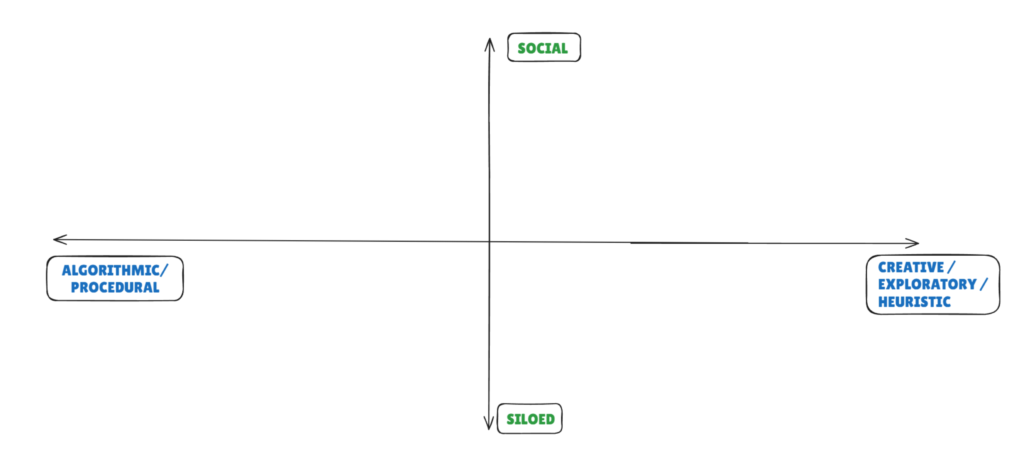
It starts with two axes and plots various types of tasks that testers do as on where they fall into the spectrum. The two axes are as follows:
- Horizontal: Algorithmic or Procedural-driven tasks → Creative or Exploration or Heuristic-driven tasks
- Vertical: Siloed tasks → Social tasks
Here’s how the four quadrants break down:
Quadrant 1: Creative + Social Work
The top-right quadrant in the image below is our Quadrant 1.
This is where human creativity meets social (team) collaboration, and AI plays a small but strategic role.
Here, the work is messy, dynamic, and deeply human. Few examples include:
- Shaping strategy in real-time with stakeholders
- Pair testing and bouncing ideas with a domain expert / team member.
- Running exploratory sessions that shift based on what you see and observere.
- Telling stories in a way that creates complelling narratives for your stakeholders.
Here, AI can only step in as your quiet assistant. It can help with polish work.
So, in a nutshell, this quadrant is about 80% Human, 20% AI
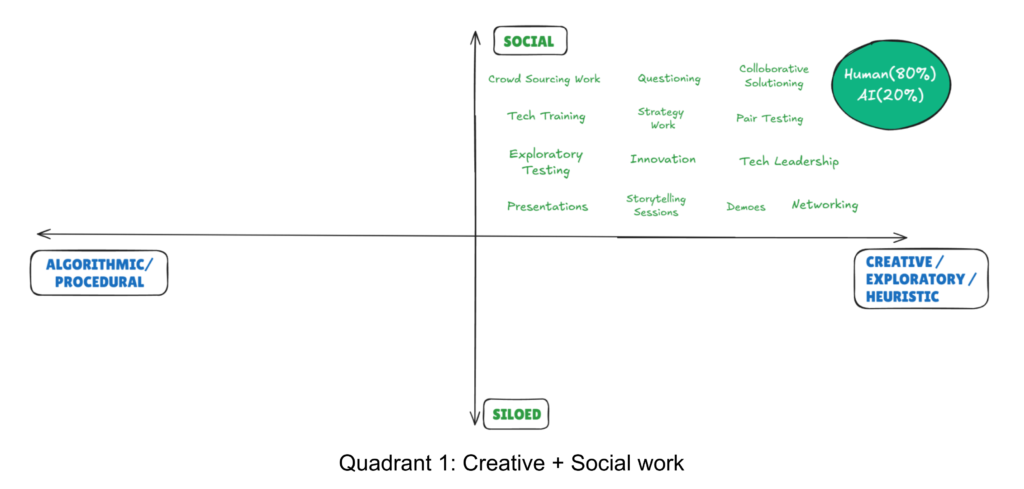
Quadrant 2: Creative + Siloed Work
The bottom-right quadrant in the image below is our Quadrant 2.
This is where human deep & focus work is required but it also calls for imagination, creativity, and flexibility.
Here, you’re shaping ideas that don’t have a clear formula. Few examples include:
- Sketching the first draft of a strategy
- Evaluating products considering various aspects and factors
- Building concepts that are flexible and open to pivoting multiple times.
Here, you’re in your own head, your own documents, and your own flow. That’s why, AI can play a bigger role here.Think of AI like a creativity amplifier for your work.
You might start by dumping raw thoughts into a doc. AI clusters them into patterns, surfaces what’s missing, and sparks tangents you wouldn’t have hit alone.
So, in a nutshell, this quadrant is about 60% Human, 40% AI.
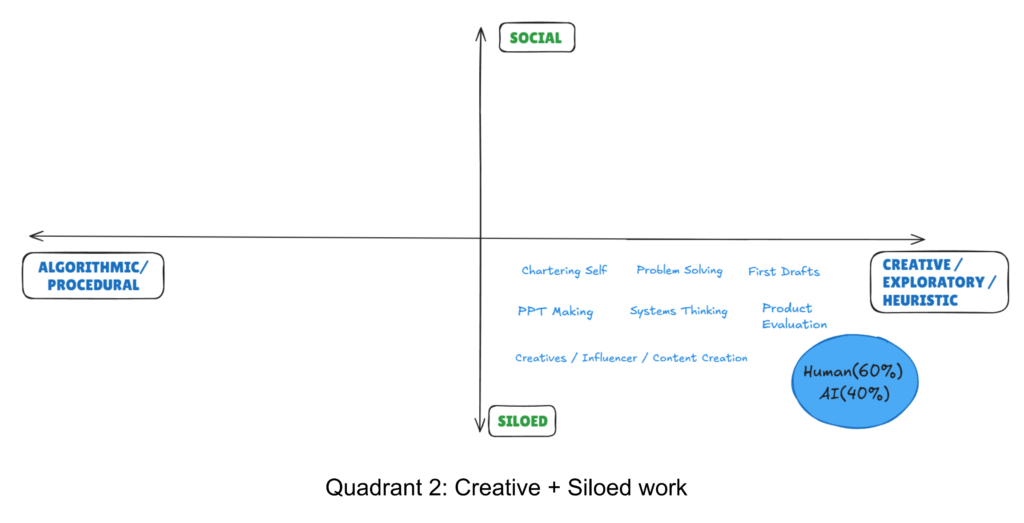
Quadrant 3: Algorithmic + Social Work
The top-left quadrant in the image below is our Quadrant 3.
This is where the workflow is predictable, but as the audience is human, clarity and context still matter.
Think of it as repeatable, rules-based tasks that happen in the social context of our work. Few examples include:
- Governance & QMS updates
- Delivery notes
- Report compilation
- Status updates in meetings
- Summarizing discussions
- Test planning and design handovers
Here, AI can handle the mechanical work such as compiling data, structuring outputs, formatting reports, whereas humans can step in to frame the message, interpret meaning, and tune it to their audience.
For example: AI can draft a meeting summary instantly from notes, but as an expert, you have to decide which points to emphasize and how to tailor it for stakeholders.
So, in a nutshell, this quadrant is about 40% Human, 60% AI.
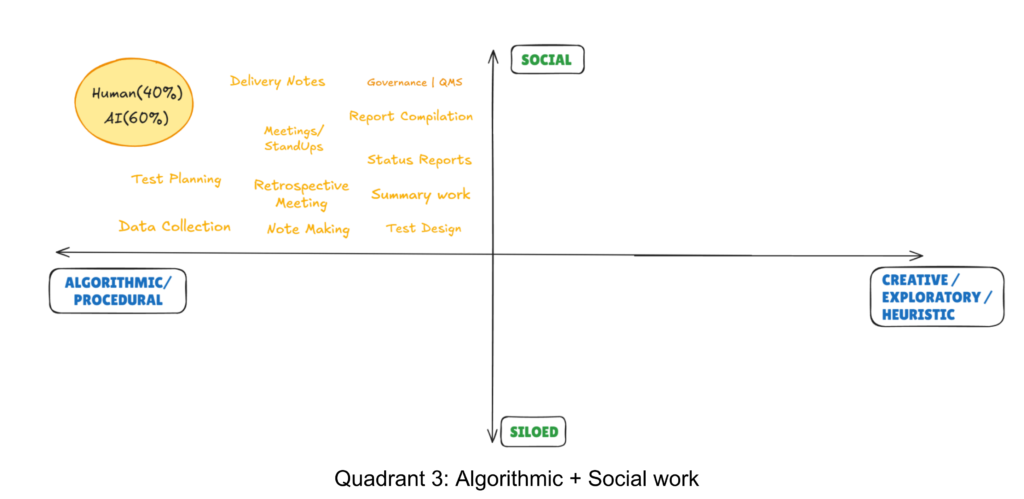
Quadrant 4: Algorithmic + Siloed Work
The bottom-left quadrant in the image below is our Quadrant 4.
This is the area of work that have clear rules, repeatable steps, and well-defined outcomes. This is the kind of work machines love and can do with higher accuracy.
The work is important, but it doesn’t need deep human judgment at every step. Few examples include:
- IT or admin requests
- Writing and running test scripts
- Generating templated reports
- Documentation updates
- CI pipeline runs
Here, your role shifts from a doer to director:
- You define the requirements and constraints.
- You review outputs for quality.
- You step in when exceptions or anomalies pop up.
In this quadrant, speed and precision matter more than originality. AI becomes your production engine and you become the quality gatekeeper freeing your time for the tasks in the above three quadrants.
So, in a nutshell, this quadrant is about 20% Human, 80% AI.
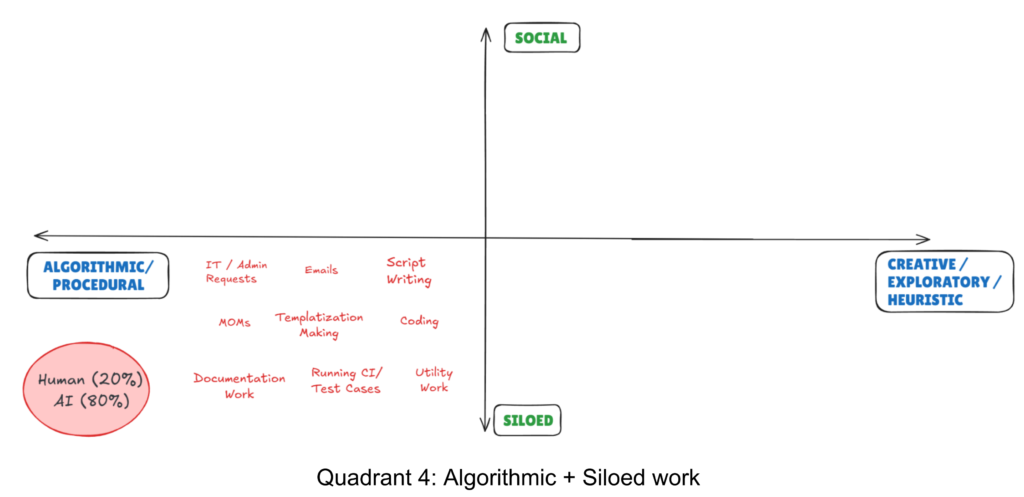
Here is a crisp summary of all 4 quadrants:
| Quadrant | Type of Work | Human Contribution | AI Contribution |
| 1 | Creative + Social | 80% | 20% |
| 2 | Creative + Siloed | 60% | 40% |
| 3 | Algorithmic + Social | 40% | 60% |
| 4 | Algorithmic + Siloed | 20% | 80% |
This quadrant model can do more than just explain you about the nature of tasks. It can also help you act, so that you:
- Know what to delegate.
- Know what to protect.0
- Know when to lean on tools, and when to trust your gut.
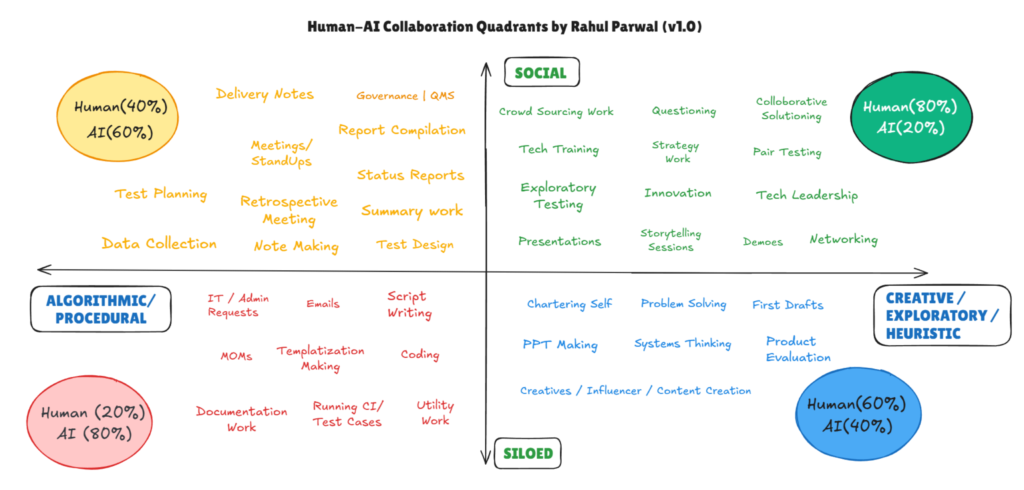
Know what to automate. Know what to own.
Testing is a strange blend of art and science.
Some tasks repeat like clockwork. Others demand intuition, creativity, and social competency.
So, let AI do the heavy lifting for clockwork kind of tasks:
- Auto-generate test scripts from patterns
- Run repetitive checks in CI pipelines
- Compile daily updates and share in a template
- Draft delivery notes from your work records / project artifacts.
But at the same time, focus more on things that give you an human edge:
- Test strategy & risk storming with stakeholder insights
- Exploratory sessions that uncover hidden truths
- Facilitate retrospectives that bring people together
- Craft demos that don’t just show features but tell stories
What could you do with one extra hour today? Start by looking up new tasks from the first few quadrants.
Shift your mindset
AI feels new and unfamiliar. It can feel threatning. But it’s not.
It’s a fast learner. A tireless helper. But it’s no genius without you.
Try thinking like this:
- AI is a draft partner, not a rival
- Prompts are conversations to augment you, not instructions to replace you
- AI output misses aren’t failures, they’re feedback that AI needs more of “you”.
- You don’t have to blindly accept AI outputs, you have to shape it
Treat AI like a junior tester. Fast, eager, but directionless. It can help you scale and accelerate. But it doesn’t understand nuance.
Social and tech nuances are where humans shine. This is where trust is built.
AI will certainly eliminate a lot of roles. But not yours, if you evolve.
Work towards growing in ways that AI can’t.
- Become a powerful storyteller of outcomes
- Learn your craft in depth so that you know how to separate noise from signal.
- Build strong ties with product and design related aspects.
- Share insights inside your team or across the industry. Sharing insights will also help you to develop better insights.
In short, focus on skills that can future-proof you in the AI age. Quadrant 1 and 2 are areas to start working on.
So, Start small. Start smart. Start now.
- Begin each day by reviewing AI’s outputs.
- Keep a prompt library. Update it. Share it with your peers.
- Let AI generate test data. Be the reviewer and quality gate for the output.
- Annotate and personalize AI drafts. Make your thinking visible.
These micro-habits will get you in a collaborative state with AI.
Build a team culture around AI
You can’t pair with AI alone. You need team rhythm.
Shared curiosity and collective learning can accelerate your collective growth.
Especially, if you are a senior or mid level expert, work towards creating a culture where AI feels normal:
- Run AI demo sessions that show real gains
- Build a prompting hub for your group
- Celebrate AI-assisted wins or time saved
- Document what didn’t work, and share that too, so that you all improve together
AI in testing is evolving fast. Collective power can only help you evolve quick.
Summary
You don’t need to compete with AI. You need to learn to collaborate with it.
Use it. Shape it. Grow with it.
- Let the Human AI collaboration quadrants model guide you to act on the right areas
- Focus on irreplaceable human work
- Make AI part of your team, don’t see it as a threat.
- Humans and AI bring different skills and capabilities to the table.
- Synergetic usage of both human and AI capabilities is essential to growth.
- Share what you learn with your team and AI group.
- Build the future of modern testing together.
AI is already here. What you do next makes all the difference. All the best!
Note: The above article was developed for the "Sharing is Caring" contest by the TestBusters Newsletter, powered by AskUI. Here is the link to the original publish.
Enjoyed this post? Here’s what you can do next:
- 📢 Share this post | Twitter | LinkedIn | WhatsApp
- 📚 Checkout my free Gen AI for Testers Course
- 📖 Buy a copy of Ultimate Productivity Toolkit
- 🎓 Book a call with me on Topmate
Thank you for reading! 😊


